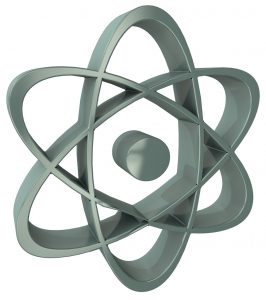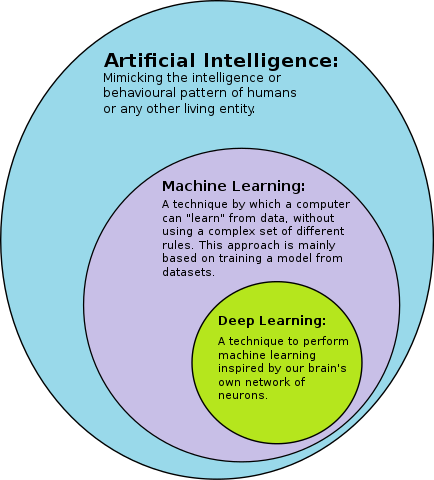
This is our 101’st blog post here on Learning Machines and we have prepared something very special for you!
Oftentimes the different concepts of data science, namely artificial intelligence (AI), machine learning (ML), and deep learning (DL) are confused… so we asked the most advanced AI in the world, OpenAI GPT-3, to write a guest post for us to provide some clarification on their definitions and how they are related.
We are most delighted to present this very impressive (and only slightly redacted) essay to you – enjoy!
Artificial intelligence (AI), machine learning (ML), and deep learning (DL) are related concepts that are often used interchangeably. They are also three distinct and different concepts. In this blog post, we will define artificial intelligence, machine learning, and deep learning and explain why they are all different and how they are related.
Artificial intelligence
AI is a broad and complex concept that has been around for decades. AI is used to describe a concept or a system that mimics the cognitive functions of the human brain. It can be used to describe a situation where machines can act or behave in a way that mimics human behavior. AI is often used to describe a system that can learn from experience, can use knowledge to perform tasks, to reason, and to make decisions.
There are many different types of AI. For example, there are expert systems, neural networks, and fuzzy logic. In this blog post, we are going to focus on the different types of machine learning. A machine learning model is an AI system that can learn from a dataset and can make predictions or decisions based on the data (see also So, what is AI really?).
Machine learning
Machine learning is a subset of AI and is a method for algorithms to learn from data. It can be used to build models that can predict future behavior based on past experience. Machine learning is used to analyze large datasets and to find patterns in the data. An example of a machine learning model is a spam filter that learns to differentiate between spam and non-spam messages.
There are three different types of machine learning. Each of them is used for a different type of problem.
Supervised learning
Supervised learning is the most common type of machine learning. It is used to find patterns in data and is used to predict future behavior based on past experience. In supervised learning, the data is split into two parts, known as the training set and the test set. The training set is used to train the model and the test set is used to evaluate the accuracy of the model.
The goal of supervised learning is to find a relationship between independent variables and dependent variables. The independent variables are the things that we know about the data. For example, the independent variables are the features that are used to describe a customer. The dependent variables are the things we want to know about the data. For example, the dependent variable is the profit made from a specific customer. The relationship between the independent variables and the dependent variables is known as the model.
Supervised learning can be used to predict the profit of a customer based on the features of the customer.
Unsupervised learning
Unsupervised learning is used to find structure in the data. In unsupervised learning, there is no training set. The model is learned from the test set. It can also be used to find groups or clusters in the data or to identify anomalies in the data.
Unsupervised learning can be used to find groups of similar customers.
Reinforcement learning
Reinforcement learning is a type of machine learning that is used to find good actions or decisions based on the data. Reinforcement learning is used to find an optimal action or decision that will maximize the reward. It is used to find the optimal solution to a problem. The optimal solution depends on the reward function.
Reinforcement learning can be used to optimize different types of problems. For example, it can be used to optimize a non-linear function or to find the shortest route in a network (see also Reinforcement Learning: Life is a Maze).
Deep learning
Deep learning is a subset of machine learning that uses artificial neural networks. Artificial neural networks are computational models that are inspired by the architecture of the human brain. They are used to develop algorithms that can learn from data (see also Understanding the Magic of Neural Networks).
Deep learning is used to build models that can classify data or find patterns in the data. Deep learning is used to perform complex tasks such as object recognition, speech recognition, and translation. Deep learning is the most popular type of machine learning.
In this blog post, we explained the difference between artificial intelligence, machine learning, and deep learning.

We also covered the three different types of machine learning (supervised learning, unsupervised learning, and reinforcement learning) and explained how they are related.
It seems almost impossible but this whole post was really written by a very advanced AI and only slightly redacted. You won’t find it anywhere else on the internet, it is unique. I think it is fair to say that we haven’t even begun to understand the full potential of this new technology…
UPDATE July 10, 2022
I created a video for this post (in German):
UPDATE December 9, 2022
Another mind-blowing application of GPT3:
ChatGPT can Create Datasets, Program in R… and when it makes an Error it can Fix that too!

If there’s one thing we can take from this, it’s that there are far too many introductory AI articles on the internet for it to learn from!
…and the AI created the ultimate introduction out of those 😉
Pretty obviously, it would be good to know what “only slightly redacted” means concretely here.
Adding the diagram was one of the few things I did. Another thing was deleting a few sentences that were repeated. But the rest came out as it stands!
Do you have the AI’s consent to modify what it said? How do you know that it didn’t purposefully duplicate certain sentances? 😀
Oh dear, I am doomed ?
So is deep learning supervised, unsupervised or reinforced? The way this is written suggests there’s four kinds of ML but it’s not clear. The difference between deep learning and the other three was not explained really. Also doesn’t deep learning use neural networks? Which is a different subset of AI? At least that’s what it seems to suggest.
Thank you for your feedback, Ta Daah, it seems you were not impressed that much…
I think the writing couldn’t be any clearer.
Deep Learning can be supervised, unsupervised (e.g. autoencoders), or be embedded in a reinforcement learning framework (e.g. the architecture of AlphaGo). Yes, as the text states: “Deep learning is a subset of machine learning that uses artificial neural networks.”
When you look at the structuring all of this should become clear:
– Artificial intelligence
– Machine learning
— Supervised learning
— Unsupervised learning
— Reinforcement learning
– Deep learning
It is also repeated in the conclusion.